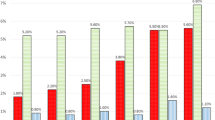Abstract
Current data suggest that up to 60 % of patients presenting to the ED with syncope leave the hospital without a defined etiology. Although a relationship between syncope and substance abuse has been described, no study to date has looked at the relationship between syncope of unknown etiology and substance abuse in patients presenting to the ED. The objective of the study was to determine whether a history of or current substance abuse is associated with an increased incidence of syncope of unknown etiology in ED patients. A prospective, observational, cohort study of consecutive ED patients aged ≥18 who presented with syncope was conducted between 6/03 and 7/06. Patients were queried in the ED and charts reviewed about a history of or current substance abuse. Substance abuse was defined as consumption of >2 alcoholic beverages nightly, repetitive use of any illicit substances, or documentation by the patient’s physician of concern regarding suspected substance abuse. Data were analyzed using SAS with Chi-squared and Fisher’s exact tests. We enrolled 518 patients who presented to the ED after syncope, 161 of whom did not have an identifiable etiology for their syncopal event. 62 patients had a history of, or current substance abuse. Among patients with a history of, or current substance abuse, 45 % had unexplained syncope, as opposed to 29 % of patients without such a history (p = 0.01). Our results suggest that prior and current substance abuse is associated with increased incidence of syncope of unknown etiology. Patients evaluated in the ED or even hospitalized with syncope of unknown etiology may benefit from substance abuse screening and possibly detoxification referral.
Similar content being viewed by others
References
Sun BC, Emond JA, Camargo CA Jr (2004) Characteristics and admission patterns of patients presenting with syncope to U.S. emergency departments, 1992–2000. Acad Emerg Med 11:1029–1034
Kapoor WN (1990) Evaluation and outcome of patients with syncope. Medicine 69:160–174
Sun BC, Emond JA, Camargo CA Jr (2005) Direct medical costs of syncope-related hospitalizations in the United States. Am J Cardiol 95:668–671
Quinn JV, Stiell IG, McDermott DA, Sellers KL, Kohn MA, Wells GA (2004) Derivation of the San Francisco Syncope Rule to predict patients with short-term serious outcomes. Ann Emerg Med 43(2):224–232
Colivicchi F, Ammirati F, Melina D, Guido V, Imperoli G, Santini M (2003) Development and prospective validation of a risk stratification system for patients with syncope in the emergency department: the OESIL risk score. Eur Heart J 24(9):811–819
Grossman SA, Fischer C, Lipsitz LA, Mottley L, Sands K, Thompson S et al (2007) Predicting adverse outcomes in syncope. J Emerg Med 33(3):233–239
Del Rosso A, Ungar A, Maggi R, Giada F, Petix NR, De Santo T et al (2008) Clinical predictors of cardiac syncope at initial evaluation in patients referred urgently to a general hospital: the EGSYS score. Heart 94(12):1620–1626
Reed MJ, Newby DE, Coull AJ, Prescott RJ, Jacques KG, Gray AJ (2010) The ROSE (risk stratification of syncope in the emergency department) study. J Am Coll Cardiol 55(8):713–721
Grossman SA, Van Epp S, Arnold R et al (2003) The value of cardiac enzymes in elderly patients presenting to the emergency department with syncope. J Gerontol A Biol Sci Med Sci 58A(11):1055–1058
Link MS, Lauer EP, Homoud MK, Wang PJ, Estes NA III (2001) Low yield of rule-out myocardial infarction protocol in patients presenting with syncope. Am J Cardiol 88(6):706–707
Abubakr A, Wambacq I (2005) The diagnostic value of EEGs in patients with syncope. Epilepsy Behav 6(3):433–434
Grossman SA, Fischer C, Bar JL et al (2007) The yield of head CT in syncope: a pilot study. Intern Emerg Med 2:46–49
Schnipper JL, Ackerman RH, Krier JB, Honour M (2005) Diagnostic yield and utility of neurovascular ultrasonography in the evaluation of patients with syncope. Mayo Clin Proc 80:480–488
Pires LA, Ganji JR, Jarandila R, Steele R (2001) Diagnostic patterns and temporal trends in the evaluation of adult patients hospitalized with syncope. Arch Intern Med 161:1889–1895
Mendu M, McAvay G, Lampert R, Stoehr J, Tinetti ME (2009) Yield of diagnostic tests in evaluating syncopal episodes in older patients. Arch Intern Med 169:1299–1305
Sarasin FP, Louis-Simonet M et al (2001) Prospective evaluation of patients with syncope: a population-based study. Am J Med 111:177–184
Farwell DJ, Sulke AN (2004) Does the use of a syncope diagnostic protocol improve the investigation and management of syncope? Heart 90:52–58
Johnson RH, Eisenhofer G, Lambie DG (1986) The effects of acute and chronic ingestion of ethanol on the autonomic nervous system. Drug Alcohol Depend 18:319–328
Carter JR, Stream SF, Durocher JJ, Larson RA (2011) Influence of acute alcohol ingestion on sympathetic neural responses to orthostatic stress in humans. Am J Physiol Endocrinol Metab 300:E771–E778. doi:10.1152/ajpendo.00674.2010
Lowenstein DH, Massa SM, Rowbotham MC, Collins SD, McKinney HE, Simon RP (1987) Acute neurologic and psychiatric complications associated with cocaine abuse. Am J Med 83(5):841–846
Olshansky B, Grubb B (eds) (2005) Syncope: mechanisms and management, 2nd edn. Wiley-Blackwell, Malden, p 217 p 214
Kapoor WN (1983) A prospective evaluation and follow-up of patients with syncope. N Engl J Med 309:197–204
Lipsitz LA (1983) Syncope in the elderly. Ann Intern Med 99:92–105
(2003) American society of addiction medicine: ASAM addiction terminology. In: Graham, AW, Shultz, TK (eds), Principles of addiction medicine, 3rd Ed, American Society of Addiction Medicine, Inc, Chevy Chase, p 1601
Olshansky B, Grubb B (eds) (2005) Syncope: mechanisms and management, 2nd edn. Wiley-Blackwell, Malden, p 217
Conflict of interest
None.
Author information
Authors and Affiliations
Corresponding author
Rights and permissions
About this article
Cite this article
Wiener, Z., Chiu, D.TW., Shapiro, N.I. et al. Substance abuse in emergency department patients with unexplained syncope. Intern Emerg Med 9, 331–334 (2014). https://doi.org/10.1007/s11739-013-1026-7
Received:
Accepted:
Published:
Issue Date:
DOI: https://doi.org/10.1007/s11739-013-1026-7




